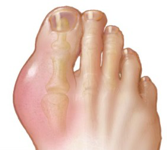What is Gout
Gout is a complex disorder that can cause sudden, severe attacks of pain, inflammation and swelling in the joints.

It is estimated that 10,000,000 Americans between the ages of 35 and 65 suffer from this condition. Men are more likely to get gout than women are, but women become increasingly susceptible to gout after menopause.
Fortunately, gout is treatable, and there are ways to reduce the risk that gout will recur.
Stages of Gout
Depending on the individual and severity of their condition, symptoms of gout may vary. For instance, did you know that there are four stages of gout? These include:
-
Asymptomatic hyperuricema
-
Acute gouty arthritis
-
Intercritical gout
- Chronic tophaceous gout
Starting with the first on this list, asymptomatic hyperuricemia patients will likely not experience any pain, inflammation or other suffering but will have high levels of uric acid within their systems. Once at the acute stage, a patient will first start experiencing irritation to his or her affected joint. The time in between gout attacks is known as intercritical gout, and chronic cases are the most painful and may occur after long-term suffering.
Signs and Symptoms of Gout
As uric acid levels first start building up within the body, you may experience warmth, swelling and tenderness to one or more joints. The next The signs and symptoms of gout are almost always acute, occurring suddenly and without warning. These include:
-
Intense joint pain.
Gout usually affects the large joint of your big toe but it can occur in your feet, ankles, knees, hands and wrists. Generally, sufferers have reported pain during the night that can last for hours at a time.
- Inflammation and redness.
The affected joint or joints become swollen, tender and red or purplish. You may experience limited mobility in the joint.
 Exams and Tests
Exams and Tests
Tests to help diagnose gout may include:
- Joint fluid test.
Your doctor may use a needle to draw fluid from your affected joint. When examined under the microscope, your joint fluid may reveal urate crystals. - Blood test.
Your doctor may recommend a blood test to measure the uric acid level in your blood. Blood test results can be misleading, though. Some people have high uric acid levels, but never experience gout. And some people have signs and symptoms of gout, but don't have unusual levels of uric acid in their blood.
Additional Information:
What is Calcic Gout?
Gout Causes
Gout Risk Factors
Gout Diet
|
|
Blog |
|
|
Gout EducationIn the event of a gout flare up, Lona Sandon, an assistant professor of clinical nutrition at the University of Texas Southwestern Medical Center, recommends cutting back on both seafoods and meats Read More |
|
|
What is Calcic Gout?Many people enjoy an ice cold beer or frozen cocktail alongside their red-meat burger or shrimp skewer. All of these menu items, however, prompt a build up of uric acid in a gout sufferer. Read More |
